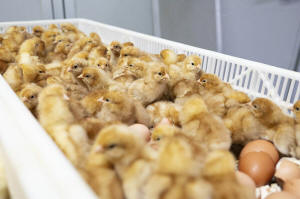The US egg industry kills 350 million chicks a year. New technology
offers an alternative
 Send a link to a friend
Send a link to a friend
 [December 19, 2024] By
SCOTT McFETRIDGE [December 19, 2024] By
SCOTT McFETRIDGE
WILTON, Iowa (AP) — Every year the U.S. egg industry kills about 350
million male chicks because, while the fuzzy little animals are
incredibly cute, they will never lay eggs, so have little monetary
value.
That longtime practice is changing, thanks to new technology that
enables hatcheries to quickly peer into millions of fertilized eggs and
spot male embryos, then grind them up for other uses before they mature
into chicks. The system began operating this month in Iowa at the
nation's largest chick hatchery, which handles about 387,000 eggs each
day.
“We now have ethically produced eggs we can really feel good about,”
said Jörg Hurlin, managing director of Agri Advanced Technologies, the
German company that spent more than a decade developing the SUV-sized
machine that can separate eggs by sex.
Even Americans who are careful to buy cage free or free range eggs
typically aren't aware that hundreds of millions of male chicks are
killed each year, usually when they are only a day old. Most of the
animals are culled through a process called maceration that uses
whirling blades to nearly instantly kill the baby birds — something that
seems horrifying but that the industry has long claimed is the most
humane alternative.
“Does the animal suffer? No because it's instantaneous death. But it's
not pretty because it's a series of rotating blades,” said Suzanne
Millman, a professor at Iowa State University who focuses on animal
welfare.
Chick culling is an outgrowth of a poultry industry that for decades has
raised one kind of chicken for eggs and another for meat. Egg-laying
chickens are too scrawny to profitably be sold for meat, so the male
chicks are ground up and used as additives for other products.

It wasn't until European governments began passing laws that outlawed
maceration that companies started puzzling out how to determine chicken
sex before the chicks can hatch. Several companies can now do that, but
unlike most competitors, AAT's machine doesn't need to pierce the shell
and instead uses a bright light and sensitive cameras to detect an
embryo's sex by noting feather shading. Males are white, and females are
dark.
The machine, called Cheggy, can process up to 25,000 eggs an hour, a
pace that can accommodate the massive volume seen at hatcheries in the
U.S. Besides the Cheggy machine in the small eastern Iowa city of
Wilton, an identical system has been installed in Texas, both at
hatcheries owned by Hy-Line North America.
The process has one key limitation: It works only on brown eggs because
male and female chicks in white eggs have similar-colored feathers.
[to top of second column] |

Newly hatched chicks are seen after being sorted in a machine that
provides a new technique to enable hatcheries to peek into millions
of fertilized eggs and spot male embryos, then grind them up for
other uses before they mature into chicks, in Wilton, Iowa, Dec. 10,
2024. This is an alternative to the longstanding practice of chick
culling when male chicks are killed because they have little
monetary value since they do not lay eggs. (Courtesy Tony Reidsma
via AP)
 That's not a huge hindrance in
Europe, where most eggs sold at groceries are brown. But in the
U.S., white shell eggs make up about 81% of sales, according to the
American Egg Board. Brown shell eggs are especially sought by people
who buy cage-free, free-range and organic varieties.
Hurlin said he thinks his company will develop a
system to tell the sex of embryos in white eggs within five years,
and other companies also are working to meet what's expected to be a
growing demand.
Eggs from hens that were screened through the new system will supply
NestFresh Eggs, a Southern California-based business that
distributes organic eggs produced by small operations across the
country. The eggs will begin showing up on store shelves in mid-July
and NestFresh executive vice president Jasen Urena said his company
will begin touting the new chick-friendly process on cartons and
with a larger marketing effort.
“It's a huge jump in animal welfare,” Urena said. “We've done so
much work over the years on the farms. How do we make the lives of
these chickens better? Now we're able to step back and go into the
hatching phase.”
Urena said the new system was more expensive but any price increase
on store shelves would be minimal.
The animal welfare group Mercy for Animals has tried to draw
attention to chick culling for more than a decade in hopes of ending
the practice.
Walter Sanchez-Suarez, the group's animal behavior and welfare
scientist, said laws in Europe outlawing chick culling and new
efforts to change the practice in the U.S. are wonderful
developments. However, Sanchez-Suarez sees them as a small step
toward a larger goal of ending large-scale animal agriculture and
offering alternatives to meat, eggs and dairy.
“Mercy for Animals thinks this is an important step, but poultry
producers shouldn't stop there and should try to see all the
additional problems that are associated to this type of practice in
egg production,” he said. “Look for alternatives that are better for
animals themselves and human consumers.”
All contents © copyright 2024 Associated Press. All rights reserved |